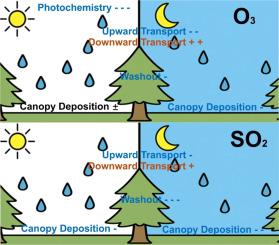Rainfall-induced changes in vertical O3 and SO2 within and above a boreal-temperate forest
IF 5.7
1区 农林科学
Q1 AGRONOMY
引用次数: 0
Abstract
This study investigates the impact of rainfall on the vertical distribution of ozone (O3) and sulfur dioxide (SO2) in a boreal-temperate forest, using multi-year observations (2009-2013) from a 42-m tower. Based on 194 persistent rainfall events, we compare the vertical O3 and SO2 concentrations between rain and non-rain conditions at the same height, hour, and month to minimize biases introduced by the background variations in time and space. In contrast to the observed O3 increases during rainfall over tropical forests, O3 during rainfall predominantly declines 2-6 ppb (10-20 %) from the surface throughout the canopy and above, except at lower layers during nighttime rainfall. SO2 exhibits a much larger reduction of 0.3-0.5 ppb (40-50 %) throughout the vertical profile. We further assess the role of four key processes, including washout, photochemistry, deposition, and vertical transport, in modulating O3 and SO2 vertical profiles during rainfall. Our analysis suggests that the substantial reduction in SO2 is mainly attributable to its high solubility, while O3 reductions during the day are largely due to declined photochemical production. Both O3 and SO2 depositions in nighttime could be moderately enhanced during rainfall with wet non-stomatal depositions, while the rainfall-induced change in daytime O3 deposition is small because rainfall-induced changes in stomatal and non-stomatal deposition offset each other. Furthermore, upward transport prevails in the rainfall periods, contributing to O3 reduction, whereas downward transport could enhance O3. These findings provide new insights into how rainfall impacts air pollutants and underscore the role of the four processes in shaping O3 and SO2 vertical distributions in boreal-temperate forests.

降雨引起的北方温带森林内外垂直O3和SO2的变化
本研究利用一个42米高的高塔的多年观测数据(2009-2013年),研究了降雨对寒温带森林臭氧(O3)和二氧化硫(SO2)垂直分布的影响。基于194个持续降雨事件,我们比较了降雨和非降雨条件下相同高度、小时和月份的垂直O3和SO2浓度,以减少时空背景变化带来的偏差。与观测到的热带森林降雨期间O3增加相反,降雨期间,除了夜间降雨期间低层外,整个冠层及以上的表面O3主要减少2-6 ppb(10- 20%)。SO2在垂直剖面上的降低幅度更大,为0.3-0.5 ppb(40- 50%)。我们进一步评估了四个关键过程,包括冲刷、光化学、沉积和垂直输送,在降雨期间调节O3和SO2垂直剖面中的作用。我们的分析表明,SO2的大量减少主要归因于其高溶解度,而白天O3的减少主要是由于光化学产量的下降。夜间O3和SO2的沉积均可在降雨期间适度增强,而日间O3的变化较小,因为降雨引起的气孔和非气孔沉积的变化相互抵消。降雨期主要以向上输送为主,有利于O3的减少,而向下输送则有利于O3的增强。这些发现为降雨如何影响空气污染物提供了新的见解,并强调了这四个过程在形成寒带温带森林中O3和SO2垂直分布中的作用。
本文章由计算机程序翻译,如有差异,请以英文原文为准。
求助全文
约1分钟内获得全文
求助全文
来源期刊
CiteScore
10.30
自引率
9.70%
发文量
415
审稿时长
69 days
期刊介绍:
Agricultural and Forest Meteorology is an international journal for the publication of original articles and reviews on the inter-relationship between meteorology, agriculture, forestry, and natural ecosystems. Emphasis is on basic and applied scientific research relevant to practical problems in the field of plant and soil sciences, ecology and biogeochemistry as affected by weather as well as climate variability and change. Theoretical models should be tested against experimental data. Articles must appeal to an international audience. Special issues devoted to single topics are also published.
Typical topics include canopy micrometeorology (e.g. canopy radiation transfer, turbulence near the ground, evapotranspiration, energy balance, fluxes of trace gases), micrometeorological instrumentation (e.g., sensors for trace gases, flux measurement instruments, radiation measurement techniques), aerobiology (e.g. the dispersion of pollen, spores, insects and pesticides), biometeorology (e.g. the effect of weather and climate on plant distribution, crop yield, water-use efficiency, and plant phenology), forest-fire/weather interactions, and feedbacks from vegetation to weather and the climate system.

 求助内容:
求助内容: 应助结果提醒方式:
应助结果提醒方式:


